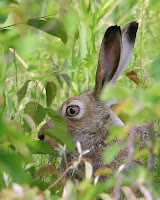Wednesday, June 13, 2007
Lost And Then Found

I am going to let you in on a secret place that I have been keeping to myself for years. The best part of this secret is that I was not aware till lately that it was a special place. My special place is a hillside near my workplace that measures approximately 50 meters by 100 meters and is very ugly in the early spring because of all the trash that has blown in from parts unknown.

 Once the grass and shrubs as well as the few trees green up things began to improve. I have spent enough time observing this tiny sanctuary to know that the main residents are four Prairie Jackrabbits, a covey of six Grey Partridges, a pair of Magpies that fight with a pair of Crows constantly. Of course there are visits by transients such as the odd coyote and I suspect the odd deer.
Once the grass and shrubs as well as the few trees green up things began to improve. I have spent enough time observing this tiny sanctuary to know that the main residents are four Prairie Jackrabbits, a covey of six Grey Partridges, a pair of Magpies that fight with a pair of Crows constantly. Of course there are visits by transients such as the odd coyote and I suspect the odd deer. 
Just to clarify something, the Grey Partridge in my photo is also know as a Hungarian Partridge. He is a non native of North America and was introduced from Europe as a Upland game bird. I have fond memories of my time growing up in Saskatchewan hunting partridge with a sweet side by side 20 gauge Fox shotgun. Today I prefer to hunt them with a camera.

One of the most amazing things that I found on this tiny hillside once I actually made my way on to it is the fact that it has all these wildflowers growing there. This is a Three Flowered Avens that is reddish in color and covered all over by fine hairs (expand the photo, it is a very pretty flower). Another common name is "Prairie Smoke".

I'm afraid that I cannot put a name to this pretty yellow flower that had not opened as yet when I found it and shot this photo. There actually were very few growing on this hillside.

I will call this flower a "Prickly Wild Rose" that grows in abundance in Wild Rose Country (Alberta). If it sounds like I am not sure that is because of all the Hybrids that occur with the similar Common Wild Rose.

There is a fair amount of "Twinning Honeysuckle Vine" growing in various patches amongst the wildflowers on this sunny hillside and seems to be spreading along the mid-slope part of the hill.

This "Wild Vetch" is the most common wildflower growing here and is part of the Pea Family.It also blooms throughout June and July and is found throughout the prairies and parkland of Alberta.

This flower was not to plentiful but is quite pretty and goes by the name "Canada Anemone". June and July is the time that it blooms.
There actually are other species of wildflowers growing on this hillside that I did not get photos of for one reason or another but will do this as they come into bloom. For those of you interested in how I captured these flower pics, I am using a 25mm extension tube between my DSLR and my 70/200 lens which allows for extreme close-ups. I keep the auto-focus shut off and focus with the zoom -ring once my camera is in position. I have my camera set for aperture priority to keep control of the aperture for proper depth of field while showing good "Bokeh" (see labels) but at the same time, keeping a close watch on my shutter speed so as not to blur the photo. If necessary to maintain a high enough shutter speed to stop camera motion, I will use a ISO of 400. I use a monopod to steady my camera and also use a 12" light disc to reflect light on to the flower. I also wear knee-pads as not to destroy my knees as I crawl around. These knee-pads work well for insect photography as well with this same setup. I found this monstrous Ant-hill on this hillside that I plan on getting close-up and personal with soon.

This is a photo looking towards the northeast which shows my hillside in this industrial part of Calgary surrounded by warehouses and commercial businesses. I don't believe that I have ever seen anyone other than myself on this neat hillside. Oh well I guess I will keep it to myself and its residents that walk on the wild side.

Of course this hillside does not disappear come winter, it just takes on a coating of snow. If you look close you will recognize the trees in this photo as being the ones in my lead photo as the sun rises on this place that is home to many but known to few. The Jackrabbits are right at home with their white coats making them hard to spot in the snow.

















No comments yet